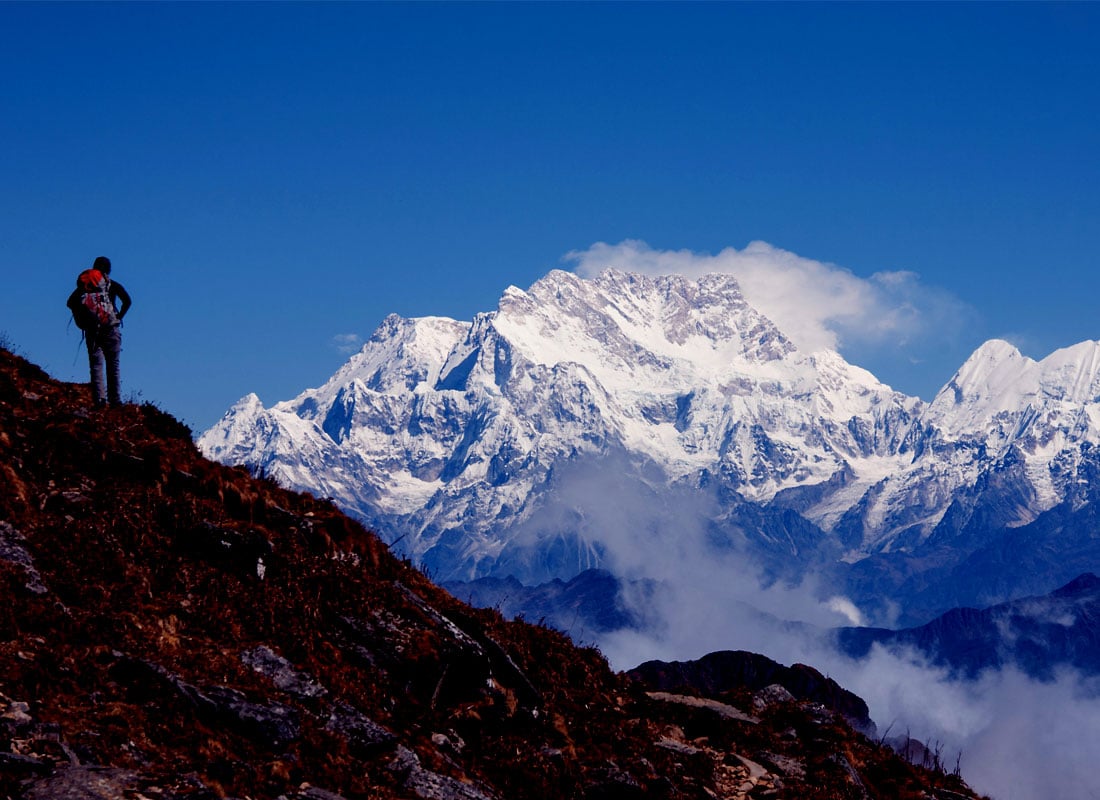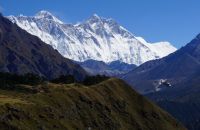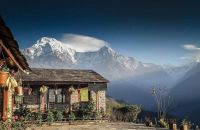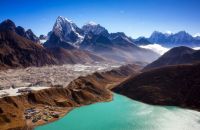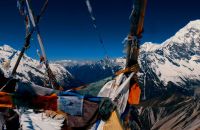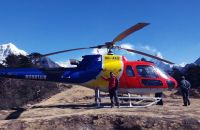Talk with our local travel specialist who can help organize your trip.
How to obtain Kanchenjunga Trek Permit?
The Kanchenjunga Trek requires you to obtain two permits, namely, Restricted Area Permit (RAP) and Kanchenjunga Conservation Area Project KCAP) permit. While trekkers can obtain KCAP from the Nepal tourism board in Kathmandu, the RAP can only be acquired by a registered Nepali trekking agency on behalf of the trekkers.
The Kanchenjunga trek is known mostly for its up-close views of Mt. Kanchenjunga, the second-highest mountain in Nepal and the third highest in the world. It was opened to trekking in the late 1980s as a restricted area and, to this day, upholds the status. The off-the-beaten trail is still remote and has the most unique and beautiful untouched wilderness, which is why it is the best trekking destination in eastern Nepal.
To explore this mesmerizing region, we are here to demystify the Kanchenjunga trekking permit acquisition. This blog has gathered all the essential details on the permits, cost, documents, and relevant information.
Necessary Permits Required for Kanchenjunga Trek and Its Cost
1. Restricted Area Permit for Kanchenjunga
There are four village development committees (VDCs) in the Kanchenjunga Region, including Yamphuding, Lelep, Paping, and Olangchung Gola in the wards of Taplejung District are designated as a restricted areas by the government of Nepal. Hence a Restricted Area Permit (RAP) is required for trekkers to enter these regions during the Kanchenjunga trek. The restricted status has been designated as the region touches the Tibetan and Indian border. This helps control tourism, protect flora and fauna and curb any illegal activities in the area.
As per the rule, only a government-registered and licensed Nepali trekking agency can apply and collect this permit on your behalf. Kanchenjunga RAP cost depends on the days you stay on the restricted area trail. Note that the cost for foreigners and SAARC nationals is the same as mentioned below.
Restricted Area Permit Cost
- For the first four weeks: US$ 20 per person/ week
- Beyond the first four weeks: US$ 25 per person /week
2. Kanchenjunga Conservation Area Project
The Kanchenjunga Conservation Area Project (KCAP) permit helps support the development and protection of the Kanchenjunga region, encompassing an area of 2,035 sq. km. There is no time limitation for this permit.
Kanchenjunga Conservation Area Project Permit Cost
- Fee for Nepali citizens is NPR 100 per person
- Fee for SAARC nationals is NPR 500 per person (US$ 5 approx.)
- Fee for other nationals is NPR 2000 per person (US$ 20 approx.)
Required Documents to Apply for Kanchenjunga Trekking Permit
To obtain the Kanchenjunga Trek permit, you will need to show the following documents during the application process:
- 2 Passport-sized photos (for KCAP)
- Scanned/ e-copy of passport size photograph (to be uploaded for Kanchenjunga RAP's online form)
- Photocopy of your valid passport
- Travel insurance papers (includes helicopter evacuation)
- Valid passport with at least six months remaining validity
- Nepal tourist visa extending past the expiry date of your RAP
- Other documents to be shown by the Trekking agency to apply for Kanchenjunga RAP (details of trekkers and guide group, Guarantee letters, Verified itinerary, tax clearance certificate, license to operate )
While the above documents might seem a lot, it will be easier as your trekking agency will follow up on the required documents from your end and then supply the rest by themselves. They will take the burden away by applying for and collecting the permits.
Featured Trips
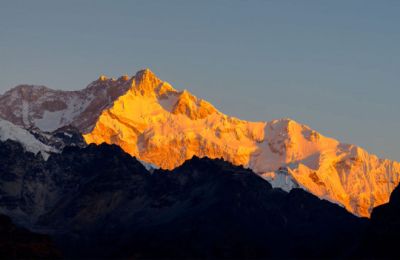
Kanchenjunga Trek - 24 days
Kanchenjunga Trek is a remarkable long remote trek into Nepal's most isolated areas of far-eastern Nepal. During 24 days Kangchenjunga circuit trek, you'll explore the area around Kanchenjunga, the third highest mountain in the world.
Inquire NowWhere to travel next?
Get help from our travel specialists for holiday ideas that matches your interests.
Kanchenjunga Trekking Permits Consideration
Some of the things that you need to consider while obtaining the Kanchenjunga Trekking permits are:
- You do not need to make payment for the permits for children under ten years of age as it is free for them.
- The permit is non-refundable, non-transferable, valid for single entry only, and for individual trekkers only.
- You must abide by the regulations of the National Park and Wildlife Conservation Act, 2029 B.S. (1973) while entering the Kanchenjunga Conservation Area.
- You need to carry the two permits throughout the trek and show it to the concerned officials on the trail as and where demanded
- The above permit costs include Value Added Tax (VAT) and other government taxes.
- Inside the conservation and restricted area, you can only enter the places designated in the permit.
- You can not acquire the RAP on your one; it needs to be processed via a valid local trekking agency on your behalf.
Where and how to obtain the Kanchenjunga Trekking Permits
Kanchenjunga Conservation Area permit
The trekkers can collect this permit. To apply, you can visit the Tourism service center in Bhrikutimandap, Kathmandu, which is open from Saturday to Sunday except on public holidays from 9 am to 5 pm. It will take you an hour or so to get the permit.
Kanchenjunga Restricted Area Permit
This permit cannot be collected by trekkers but must be obtained by a valid Nepali trekking agency. They will apply for this permit online with all the documents received by you and the ones prepared by them after you land in Kathmandu. They will then collect the permit from the Trekking Department of Nepal Immigration office located in Maitighar, Kathmandu, which issues it. This permit is not issued by Nepal Tourism Board or TAAN. It will take them no more than 2 hours to collect it.
Note that both of these permits can be applied for and collected by your chosen trekking agency hassle-free. The time taken for them to obtain the permits can be utilized by taking a free day in Kathmandu, where you can enjoy sightseeing.
Featured Trips

Kanchenjunga North Base Camp Trek - 15 days
Kanchenjunga North Base Camp trek is a short trek route that leads to the popular north base camp of Mt. Kanchenjunga and lies at a higher altitude than the south base camp
Inquire NowWhere to travel next?
Get help from our travel specialists for holiday ideas that matches your interests.
Frequently Asked Questions for Kanchenjunga Trekking Permit
1. Do you need a TIMS card for Kanchenjunga Trek?
You do not need a Trekkers Information Management System (TIMS) card for any trek that requires a Restricted Area Permit. Hence, with its restricted area status, the Kanchenjunga trek also does not require TIMS.
2. Do you need a guide for the Kanchenjunga trek?
Yes, as per the government, one licensed professional guide is mandatory. Kanchenjunga trekking trail takes you to restricted areas, most of which are remote and distant from civilization. Moreover, you will learn about the unique flora and fauna of the region, the ethnicities, religions, and the history of the communities in the area. Taking a guide makes it safer and easier to follow the trail without getting lost.
3. Can you do a solo Kanchenjunga trek?
No, it is not possible and not suggested for you to do the Kanchenjunga trek alone. As stated by the government, there must be a minimum of two trekkers (including one guide) for this trek. The trail will take you to restricted and remote areas. It is also advised to do the trek with a group for safety reasons.
4. How difficult is the Kanchenjunga trek?
Kanchenjunga Trek is graded as moderate to difficult on the difficulty scale. The factors that contribute to it are the high altitude, unpredictable weather, remoteness, off-beaten trail, and length of the trek.
Kanchenjunga trek covers 10 to 11 km/day, requiring you to walk an average of 7 to 8 hours/ day for about 17 to 18 days. There are multiple high passes to cross, which are beyond 4,500m. Moreover, the highest altitude reaches beyond 5,000m which can cause breathlessness or even altitude sickness for some.
Trekkers need to have good physical fitness to complete it. The trek will be much easier to conquer if you follow the itinerary well and take a guide and a porter along.
Conclusion
The two permits for Kanchenjunga Trek can be obtained easily with the help of a trusted professional trekking agency in Nepal. To plan and organize your trek and help you understand the permits' requirements, you can get in touch with Third Rock Adventures. Our expert team will ensure that you acquire the permits easily and promptly. Experience a hassle-free journey to the remote and lush Kanchenjunga region.
- Written by: Naba Raj Amgai
Updated: Jun, 20, 2022

